TWO-STROKE TUESDAY: THE STRANGEST VINTAGE YZ PROJECT EVER! 1979 YAMAHA YZ125F MONOSHOCK
 If you are thinking that we put a giant on the 1979 Yamaha YZ125, guess again. Bikes were shorter, smaller, lower and lighter 46 years ago. The gear: Jersey: Answer Racing Arkon Korza, Pants: Answer Racing Arkon Korza, Helmet: Arai VX-Pro4, Goggles: Viral Brand Factory Series, Boots: Sidi Atojo.
If you are thinking that we put a giant on the 1979 Yamaha YZ125, guess again. Bikes were shorter, smaller, lower and lighter 46 years ago. The gear: Jersey: Answer Racing Arkon Korza, Pants: Answer Racing Arkon Korza, Helmet: Arai VX-Pro4, Goggles: Viral Brand Factory Series, Boots: Sidi Atojo.
BY DAN ALAMANGOS
Living in rural Australia, my parents never had enough money to buy me or my five brothers anything new. Almost everything in our house was second-hand, and Dad taught us how to repair or rebuild anything that broke. As you would imagine, my five brothers and I were fascinated by all things mechanical. We were always looking for old engines to wrench on so that we could stuff them into go-karts.
We envied the neighbor kids down the road because they had an XR75 and YZ80. That made us want to get motorcycles. We finally saved enough money to buy two used bikes. My brother Phill bought a 1977 KX400, while my brother Matt and I shared a 1975 CR125. We were hooked for life. After my older brothers graduated from high school, they got real jobs and made enough money to buy new bikes and go racing. We raced at all the local motocross tracks and often ventured south to race against the fast guys from Sydney, Melbourne and Adelaide.
 This is what the 1979 Yamaha YZ125 looked like after 44 years of neglect.
This is what the 1979 Yamaha YZ125 looked like after 44 years of neglect.
But, like all Australians, we wanted to race in America. Southern California was the Mecca of motocross, and we dreamed of Saddleback, Carlsbad and Indian Dunes. My brother Phill and Matt hooked up with Australian motocross stars Stephen Gall and Anthony Gunter to make the trip to SoCal to race against the almost mystical Americans in the late 1970s. As amazing as it sounds, Stephen Gall was friends with Motocross Action magazine’s Jody Weisel, and Jody let the Aussies stay in his house while they were getting settled and learning to drive on the wrong side of the road. When Phill and Matt came home, they regaled us with stories of Banzai Hill, the Carlsbad Freeway, Motocross Action and Shadow Glen.
“EVENTUALLY, JODY LET US RACE MXA TEST BIKES. PEOPLE WOULD ASK HIM WHAT THOSE TWO CRAZY AUSTRALIANS WERE TESTING AND JODY WOULD SAY, “THEY ARE TESTING PLASTIC COMPONENTS…ON OTHER RIDERS’ BIKES.”
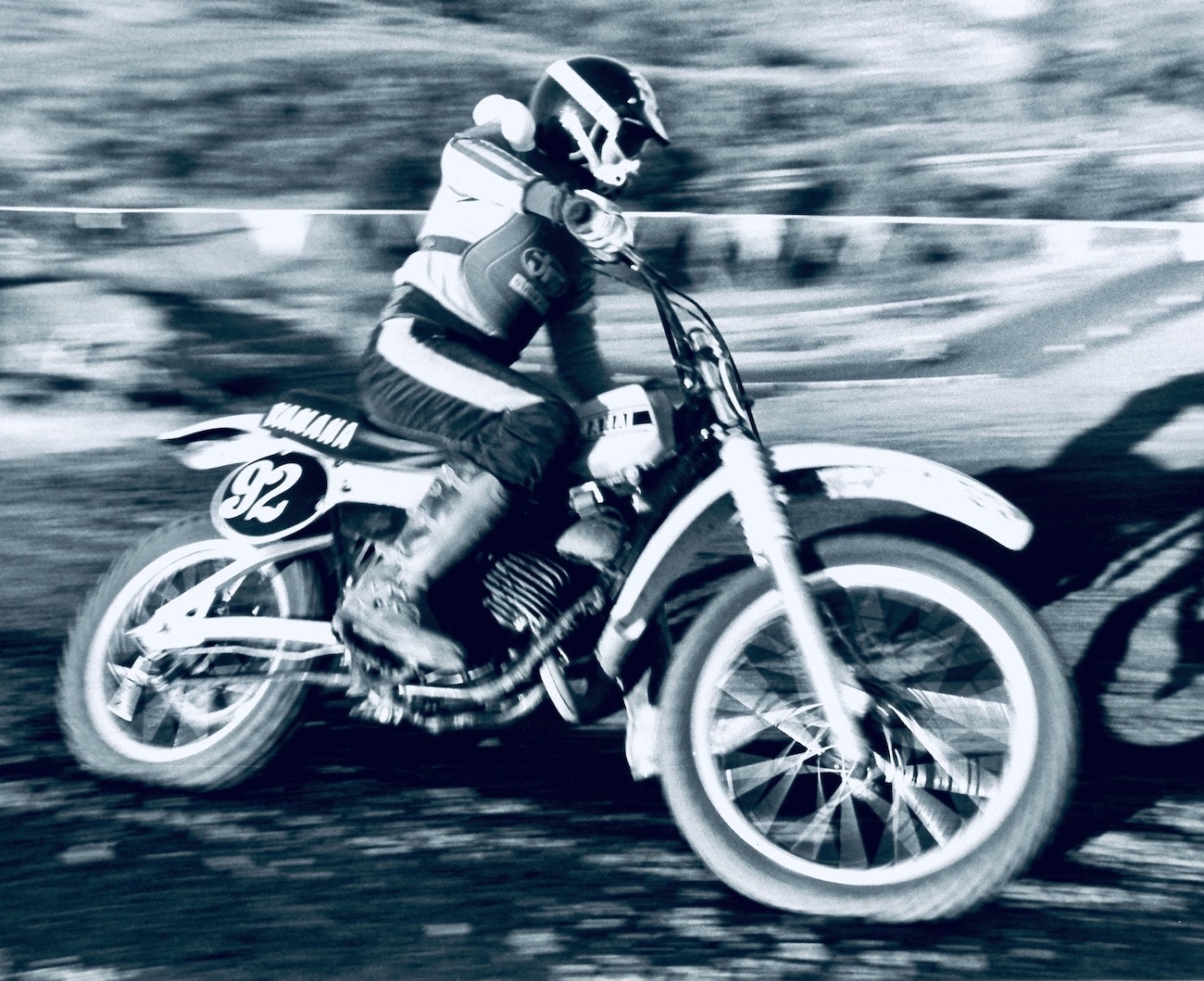 Jody Weisel at Saddleback Park in October of 1978 racing the 1979 Yamaha YZ125 when it was stock.
Jody Weisel at Saddleback Park in October of 1978 racing the 1979 Yamaha YZ125 when it was stock.
A few years later, it was my younger brother Chris’ and my turn to attack America. Unfortunately, we arrived too late for Saddleback Park (it had been shuttered behind a locked gate forever; we only had the chance to walk around the legendary track). We moved to California and started racing, It was at the local tracks where we met Jody and the rest of the MXA gang. We formed a quick friendship, as Australians are very friendly people, and eventually Jody let us race MXA test bikes. People would ask him what those two crazy Australians were testing, and Jody would say, “They are testing plastic components—on other riders’ bikes.”
Flash-forward 29 years, and I’m still testing bikes for MXA, which is where I first laid eyes on the 1979 Yamaha YZ125. After MXA was finished with the test in 1979, an editor bought it from Yamaha through a dealer for a good price, but left it in the MXA warehouse when he moved back home. That is where it sat. When MXA moved from its Encino offices to Mission Hills, the office manager said that the bike wasn’t coming along on the move, so if MXA wanted it, they should take it home. Jody called the long-gone editor, who was 3000 miles away, and asked him what to do with the bike. He said, “Whatever you want.” Jody pushed it into his barn, and that is where it sat.
In all the times that I had been in Jody’s barn, I never paid any attention to the forlorn-looking yellow Yamaha in the corner. Then one day I asked Jody, “Is that the YZ125 from the photo of you looking down at it at Saddleback when it broke; the one with the caption that read, ‘Jody contemplates shooting it.’”
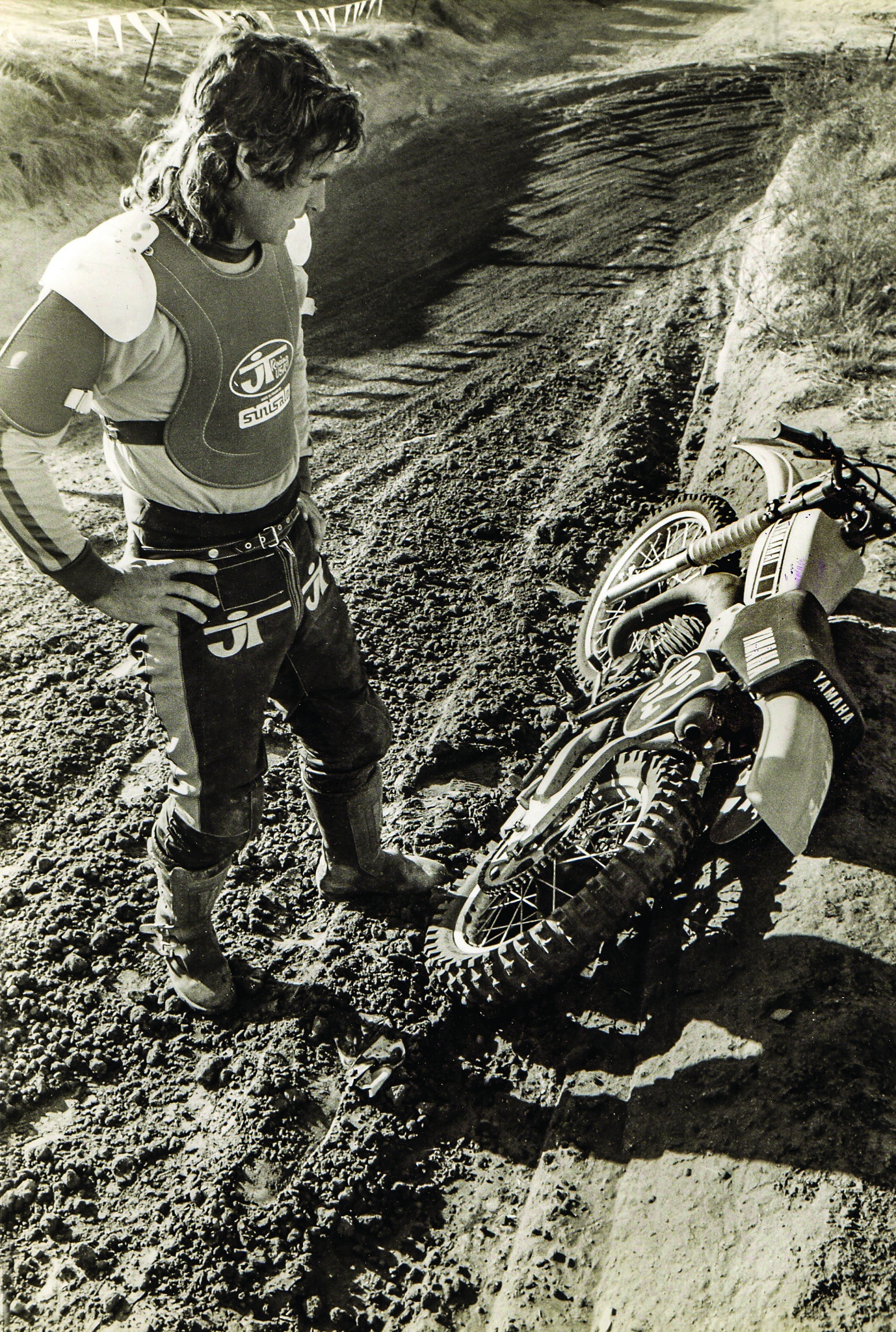 This old photo of Jody at Saddleback had a caption that read, “Jody contemplates shooting it.”
This old photo of Jody at Saddleback had a caption that read, “Jody contemplates shooting it.”
He nodded yes. At first glance, the YZ125 was nothing special. It didn’t win the “1979 125 Shootout,” and I had never owned a Yamaha. I was a Honda guy. But, a couple months earlier, Jody had rolled his 1967 Suzuki twin-cylinder road racer out of the barn and let us start it. It fired right up, and we did a few laps around his 1-acre backyard — until we crashed it. Then, it went back into the barn for another 54 years. But, hearing that five-decade-old two-stroke twin shriek got me interested in looking at the 1979 Yamaha YZ125F again.
I asked Jody if I could restore it. “Why?” he asked.
I told him that I loved to make things run again, that I was 16 years old in 1979, and that was the era I loved the most. I was fascinated by the funny-looking front fork and, after all, that was the YZ125 from all the photos in the magazine.
He said, almost matter-of-factly, “If you restore it, you can have it.”
“I’M A CARPENTER AND RESTORE HOMES, BUT I’VE NEVER RESTORED A MOTORCYCLE; BUT, I WORKED WITH MY HANDS EVERY DAY AND KEPT MY RACE BIKES RUNNING FOR DECADES.
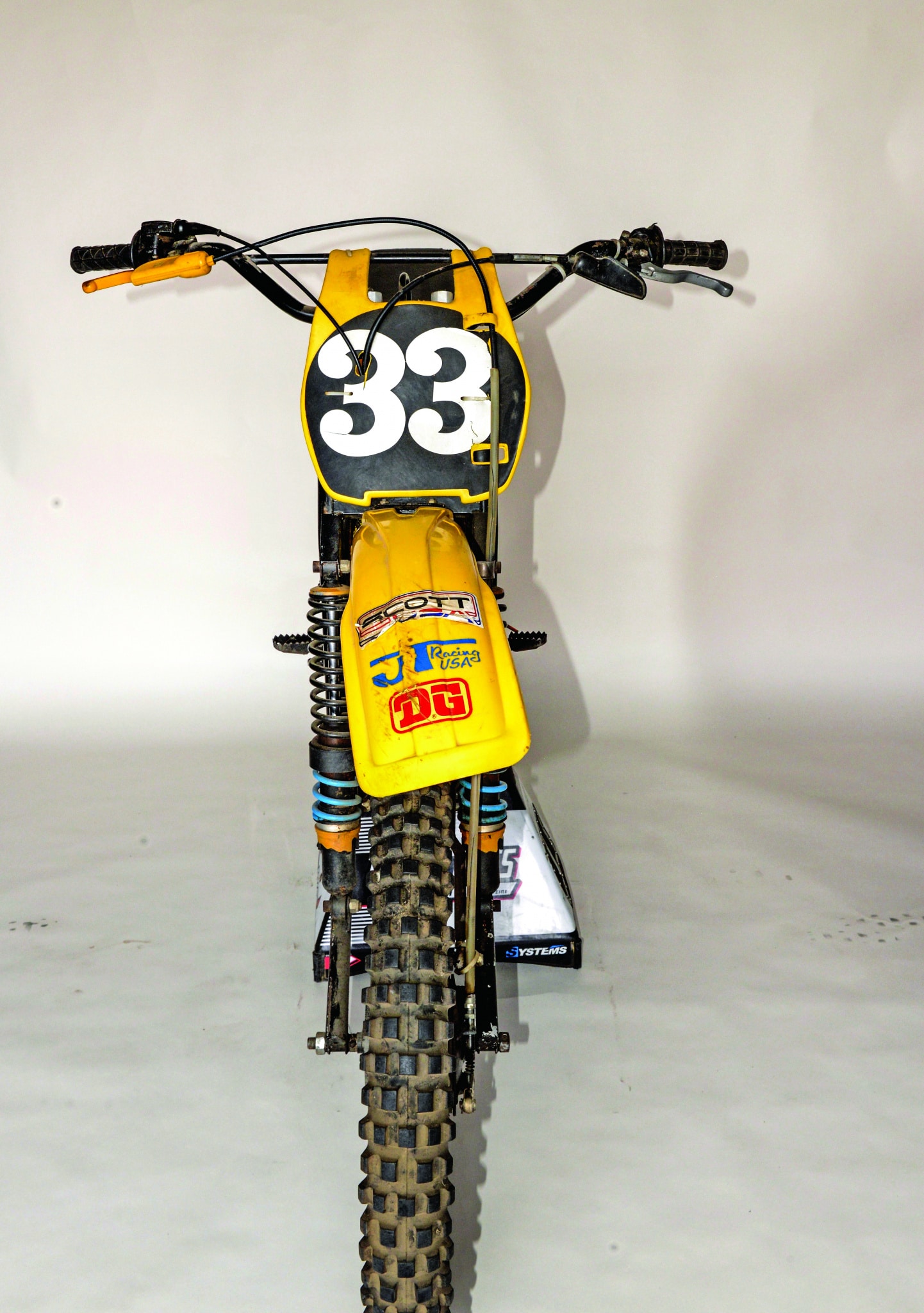 The hardest part of the YZ125 to fix was the front fender.
The hardest part of the YZ125 to fix was the front fender.
I’m a carpenter and restore homes, but I’ve never restored a motorcycle; but, I work with my hands every day and kept my race bikes running for decades. Plus, I know lots of high-profile motorcycle collectors that I could trust for guidance. My ace-in-the-hole was my friend Rick from RC Classics. His business is restoring old motocross bikes, and he was more than willing to give me some help. I told Rick that I wanted to do most of the restoration myself, keep the bike as close to the way it looked when MXA had it, and not add any aftermarket parts that weren’t on it when it was raced back in 1979, which limited me to the Rich Thorwaldson-designed leading-link Thork forks and Bob Fox-designed YZ125 Mono Airshox.
Rick’s first advice was that I search on the web to find as many New Old Stock (NOS) parts as possible. There weren’t very many, but I took a quick survey of what I needed and bought all that were available from Yamaha dealerships around the country.
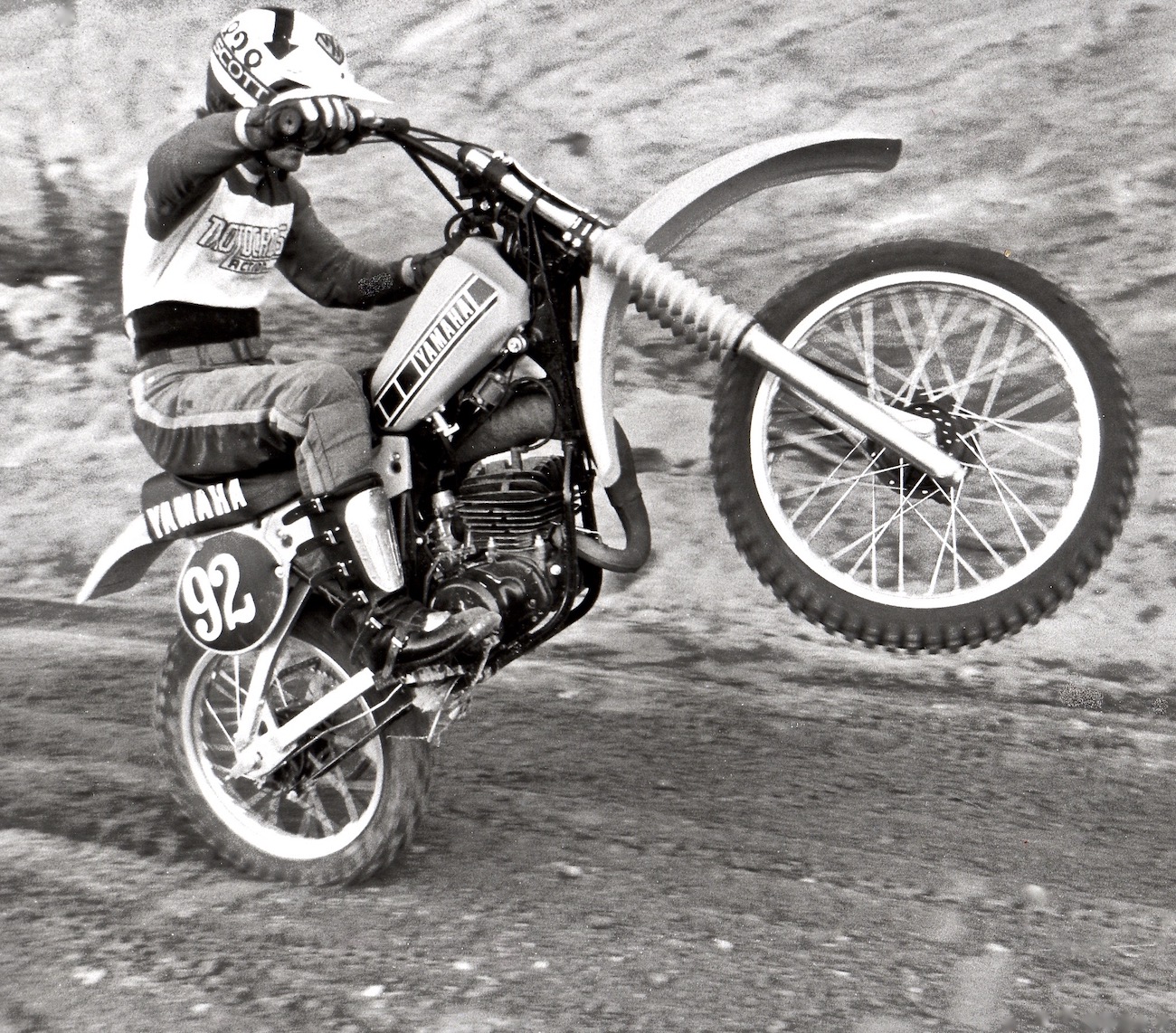 What it looked like in action—when it was new.
What it looked like in action—when it was new.
The bike was mostly complete, as it had been kept in a dry environment and for the most part was in decent condition, if aged slightly by 44 years of storage. There were a few areas of concern.
(1) Foam. During its years of storage, mice had set up home in the airbox and had a sweet tooth for the air filter and seat foam.
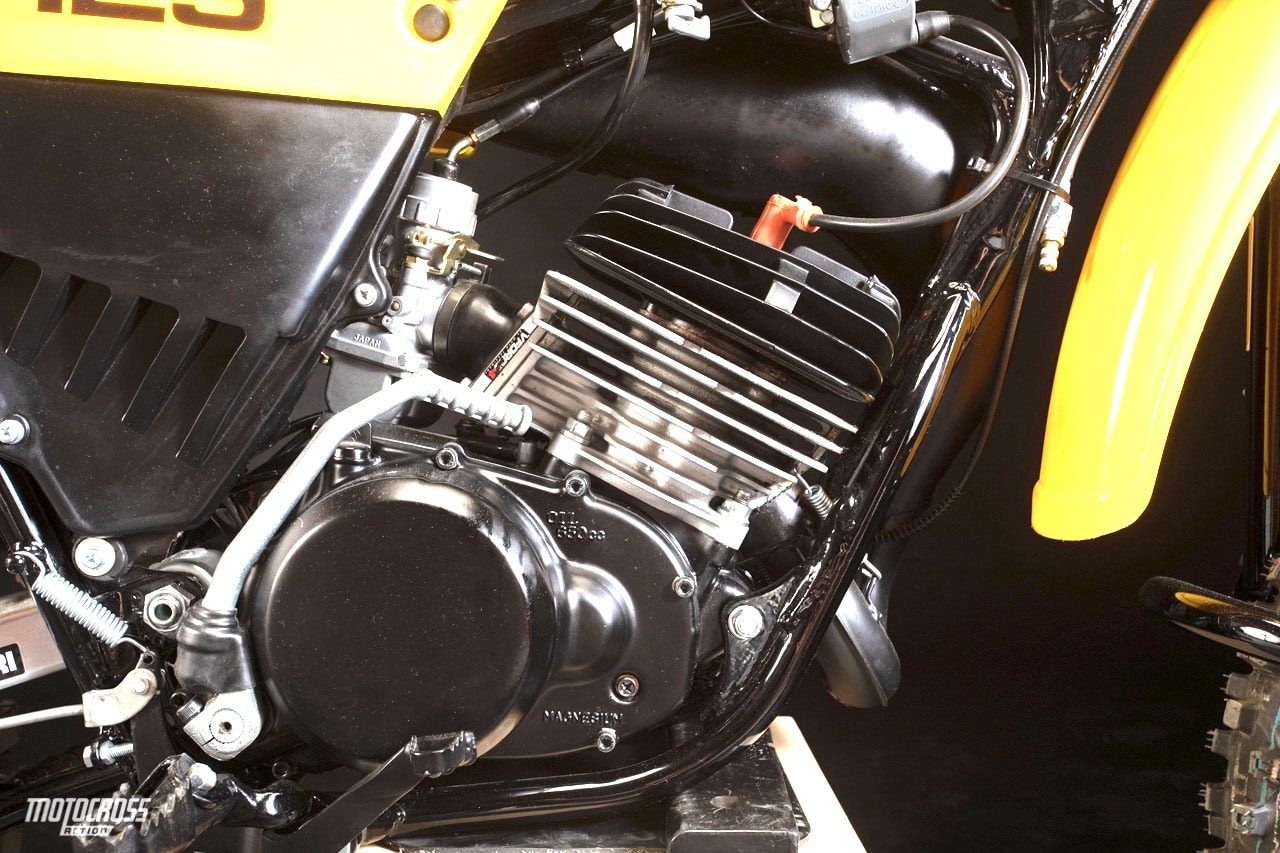 To get the engine to run right, there were a few quirks that had to be ironed out.
To get the engine to run right, there were a few quirks that had to be ironed out.
(2) Engine. I never expected the engine to run and didn’t really care, because I had always planned to rebuild the engine from the ground up. I knew the bike had been raced hard in 1979, but because it was an air-cooled engine on the cusp of the introduction of water-cooling, which came to the YZ125 in 1981, it had been relegated to trail riding duties once it was made obsolete by advancing technology. Strangely, the 1980 Yamaha YZ125 was identical to the 1979 model, but for some unknown reason, Yamaha moved the chain drive from the left side of the engine to the right, where it stayed until 1986.
(3) Suspension. What had first attracted me to the old bike sitting in the back of the barn was its strange suspension. It was weird-looking, but I was assured by people older and wiser than me that this 1979 YZ125 was equipped with genuine, circa-1979, cutting-edge suspension components. The forks were an updated take on the 1970 leading links that came on Greeves and DKW motocross bikes of the era. A famous factory Suzuki racer named Rich Thorwaldson had designed the forks, which were aptly called “Thorks” (Thorwaldson forks), to take advantage of the leading link’s ability to absorb energy by folding up and back when hitting bumps. Thorwaldson had eliminated the biggest gripe about old-school leading links by making the front brake full floating, which stopped the linkage from getting stiffer under hard braking.
 The only visible clue that the YZ125 had a Fox Mono Airshox was the braided line with the Shraeder valve sticking out from under the gas tank.
The only visible clue that the YZ125 had a Fox Mono Airshox was the braided line with the Shraeder valve sticking out from under the gas tank.
The rear shock was a Fox Racing Mono Airshox. At first I didn’t notice it. The ultra-long version of Fox’s popular Airshox was hidden completely out of sight as it ran under the airbox and gas tank. It was only when I saw the braided steel line with a Schrader valve on it sticking out the front that I realized the bike had an air shock. Back in 1979, the Mono Airshox retailed for $225, and while it was cutting-edge technology for that time (and lately when KTM raced with its WP air shock), it never reached the popularity of Fox’s twin Airshox that were on virtually every factory bike in 1977–1978. But, it was a found gem that spoke of this YZ125’s era.
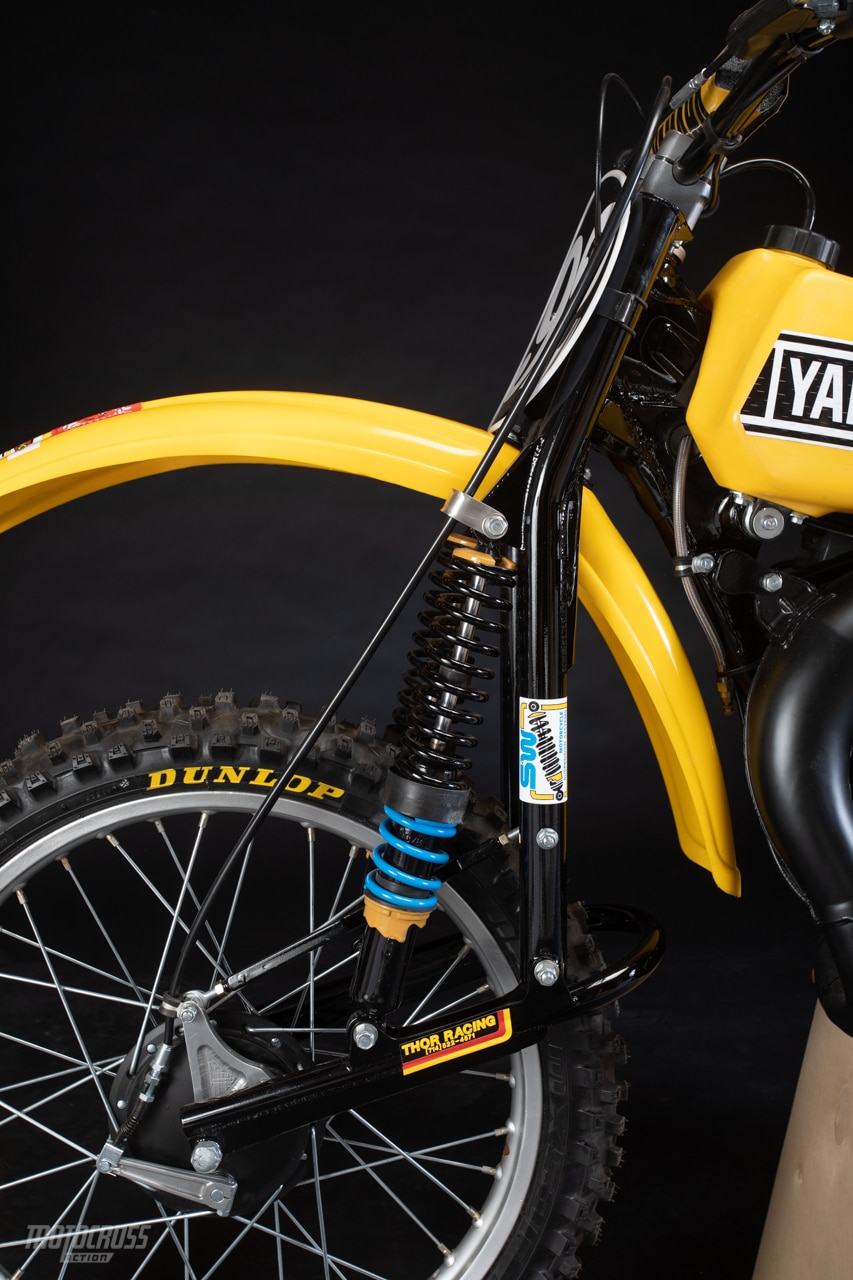 Obviously the Thorwaldson leading link forks were the weirdest part of the worn-out 1979 YZ125, but also the coolest part.
Obviously the Thorwaldson leading link forks were the weirdest part of the worn-out 1979 YZ125, but also the coolest part.
(4) Miscellaneous. When it was an MXA race bike, this bike was kept in perfect condition, but as a hand-me-down trail bike, it had scratched-up fenders, paint chips on the forks, a plastic brake lever and aftermarket clutch lever, missing decals, and the black paint was worn off the clutch and airbox covers. Worst of all, the front fender had been leaned against something while in storage, and it had a permanent twist to the left.
(5) Engine. My first step was to strip the engine down completely. Once it was dismantled, I vapor-blasted it and handed it to Jay Clark for a rebuild. The cylinder was bored to second-over. The crank was rebuilt, and new seals, bearings, clutch plates and gaskets were added. I got all the engine parts from Vintco, which carries parts for a wide variety of vintage motocross bikes. The final engine touch was to add new Vintco cables. With the engine rebuilt, I painted the cases with a low-gloss, black urethane paint, but I kept the cylinder in a raw vapor-blasted state to give it that works-bike look. All hardware, apart from a few NOS screws, including the spokes, were zinc-plated.
“THE AIRBOX WAS ALSO IN GREAT SHAPE DESPITE BEING A HOME FOR RODENTS—PERHAPS THE YEARS OF BUILT-UP GREASE AND AIR FILTER OIL DISCOURAGED MICKEY AND MINNIE FROM EATING THE PLASTIC.”
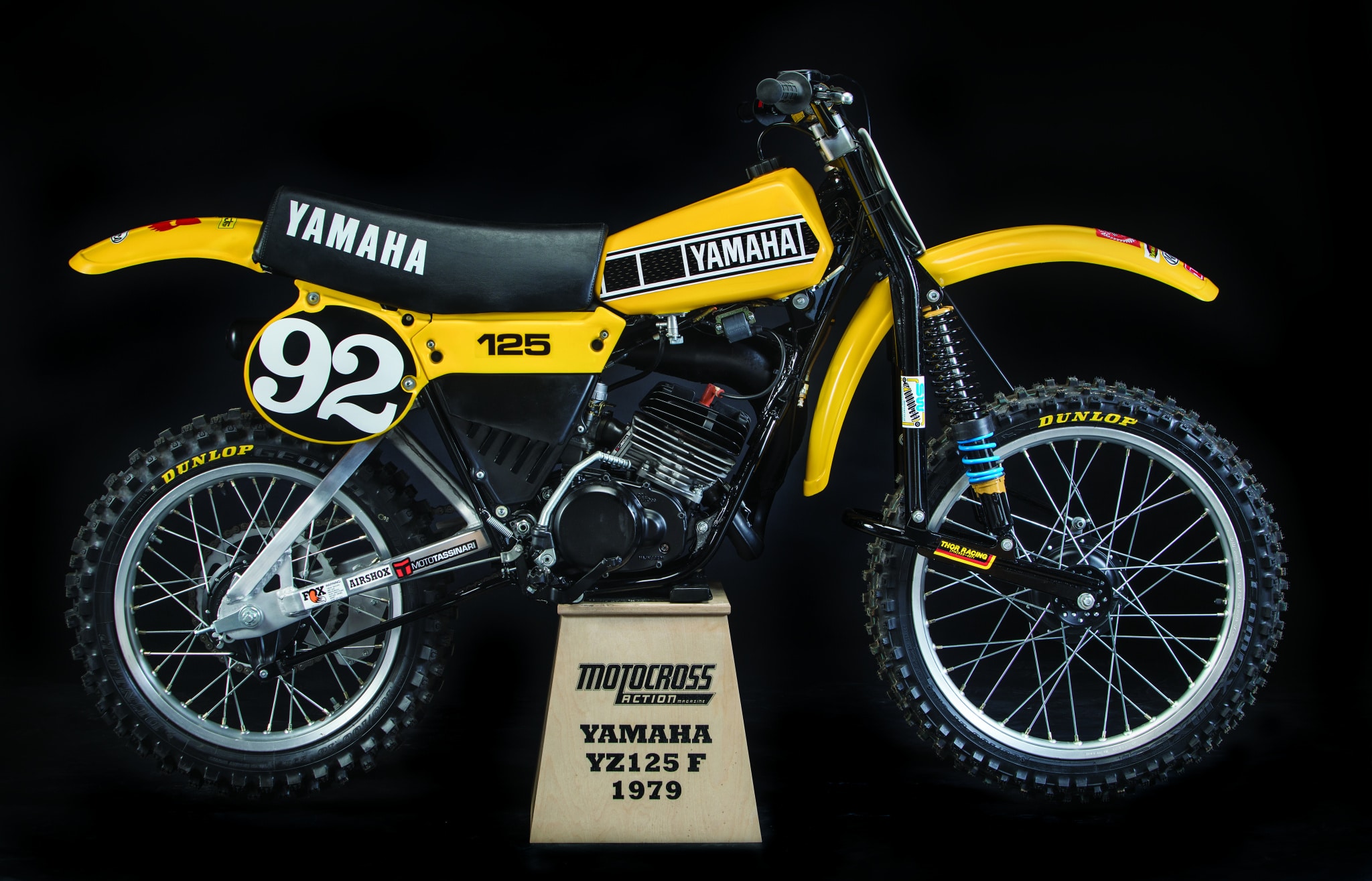 Although hidden in the corner of a barn for decades, it was made brand new by an Australian test rider who remembered it from a photo he saw when he was 16 years old.
Although hidden in the corner of a barn for decades, it was made brand new by an Australian test rider who remembered it from a photo he saw when he was 16 years old.
(6) Intake tract. The 32mm Mikuni carb was ultrasonically cleaned and vapor blasted, and new screws, jets and a gasket were installed. The 1979 intake boot was cracked, so I located an NOS Yamaha intake boot in the Netherlands (that was the only new one I could find). I had planned to run a Moto Tassinari V-Force reed block, but it required cutting the intake boot to get it to fit. And given the trouble it took to get a new boot from Amsterdam, I couldn’t bring myself to cut it up. The airbox was in great shape despite being a home for rodents—perhaps the years of built-up grease and filter oil discouraged Mickey and Minnie from eating the plastic (only a small part of the filter cage was missing, but it was still serviceable). A new foam air filter from Twin Air was installed, and an NOS rubber flap arrived a few weeks later.
 Somehow the stock exhaust pipe had survived in decent condition.
Somehow the stock exhaust pipe had survived in decent condition.
(7) Exhaust pipe. The stock pipe was in great condition with only a few small dents on the head pipe, but the judicious application of heat from a gas torch and compressed air removed them nicely. The YZ125 had lost its stock silencer years ago and went into the barn with an aluminum Answer spark arrestor-type silencer. I quickly discarded it and went looking for a stock 1979 steel silencer. I could not find one in good enough shape to justify buying, so after a few weeks I found a 1980 YZ250 silencer that I modified to fit the smaller diameter stinger; it sounded a lot better than the raspy 125 silencer. The pipe and silencer were given a coat of low-gloss black heat paint.
(8) Chassis. Of all the work that the well-used 1979 YZ125 needed, the least had to be done to the chassis. The swingarm was given the bare-aluminum works look, while the original fenders, tank and side covers were painstakingly sanded and polished before new decals were applied. I found new aftermarket seat foam on eBay, but after three tries at finding a new seat cover that would fit, I was lucky that Vintage Roost came to my rescue with a perfect-fitting cover. DG Performance found some vintage steel handlebars in their warehouse attic.
(9) Wheels. The frame was stripped to bare metal and painted in high-gloss urethane black. As for the front and rear hubs, I vapor-blasted them and applied a coat of semi-gloss urethane, installed new bearings and brake shoes, and then reassembled and trued them using the existing rims (they were in great condition). Amazingly, IRC still made the GS-45 tires that came on the 1979 YZ125 as OEM fitment, but only in CRF80 and KLX-110 sizes. Thankfully, Dunlop provided the correct size tires for the YZ125F.
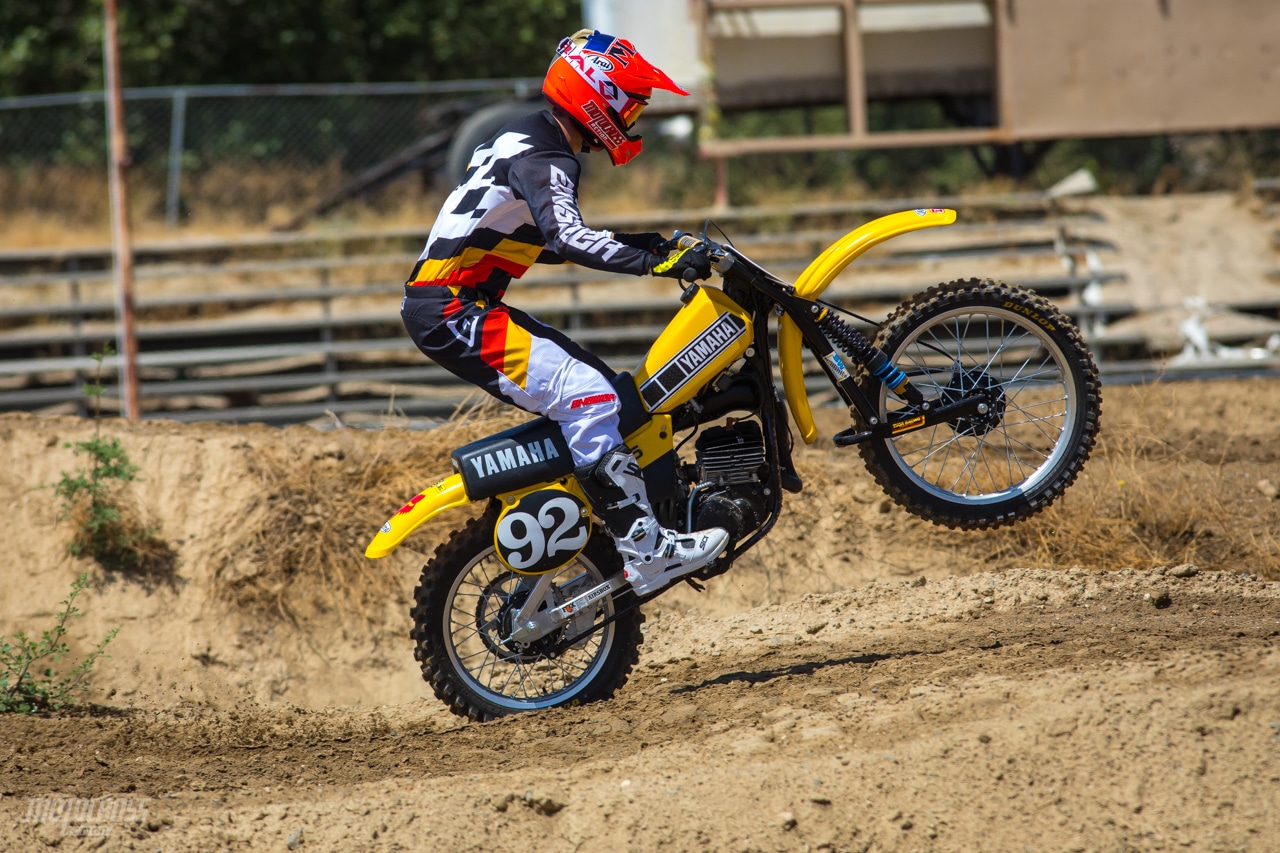 The power was weak down low, but it came on hard in the midrange. It didn’t make 2024 horsepower numbers, but it covered ground fast.
The power was weak down low, but it came on hard in the midrange. It didn’t make 2024 horsepower numbers, but it covered ground fast.
(10) Suspension. The Thorks were a mystery to me, and I wondered out loud about the whereabouts of the stock 9-1/2-inch travel Kayaba telescopic forks. I could hear the gasps from the MXA wrecking crew. You would have thought I said something nice about the AMA. Public consensus was that the Thorks made the 1979 Yamaha YZ125F unique and time-stamped it as a product of the changing of the suspension guard. In my defense, I said that the forks looked heavy, but the MXA guys took great joy in weighing them to prove that they were several pounds lighter than a set of oil-filled, coil-spring, telescopic forks. Finally, I was convinced, and I’m glad, because they make the bike stand out in a crowd. The Thorks were stripped and repainted, while the almost unused S&W front shocks were still in working order.
“THE ENGINE FIRED RIGHT UP ON THE SECOND KICK. IT MADE ME PROUD TO HEAR THE OLD GIRL RUN, BUT AFTER A FEW MINUTES, MY SMILE TURNED TO A FROWN AS I SAW THE TELLTALE SIGN OF A HEAD-GASKET LEAK.”
 This is what it looked like when it was restored to new or better condition.
This is what it looked like when it was restored to new or better condition.
As the bike sat in the barn, the Fox Racing Mono Airshox held the rear end up, but it had a slow leak that dropped the tail of the bike down after a day or two. Jody said he would call Bob Fox personally and see if he could fix the shock’s seals, but I knew a Texas company named Vintage Works MX that said they could make the Fox Monoshox new again. I called them at (949) 230-1467. The shock came back from the Lone Star State good as new.
(11) Troubleshooting. I carefully assembled the bike and added some NOS Oury grips and the original racing number (per the January 1979 cover of when the bike was new). The final steps were a thorough cleaning and a tank full of gas. The engine fired right up on the second kick. It made me proud to hear the old girl run, but a few minutes later my smile turned to a frown as I saw the telltale sign of a head-gasket leak. I re-torqued the head bolts and tried again — no luck. The initial thought was that the cylinder head was warped. I called engine builder Jay Clark for advice, and he suggested that I have the head and cylinder re-surfaced. Not defeated, I had the head and cylinder off in 10 minutes; but, as I looked at them, I realized that the head gasket didn’t look right. The top of the cylinder had a recessed step in it, and my head gasket was perfectly flat. I called Jay to double check, and he assured me that I had the correct gasket for a 1979 YZ125F cylinder head. However, I ended up researching all available YZ125 head gaskets and found the perfect fit.
I asked Jody, and he said that the only time the engine was taken apart was when it spun a main bearing at Saddleback Park and Yamaha’s Ed Scheidler rebuilt the engine. He suggested that perhaps Ed had installed unknown parts from the Yamaha test department.
 The front brake is modified to float to keep the forks from rising up under hard braking.
The front brake is modified to float to keep the forks from rising up under hard braking.
The next step was to break it in. I took it to Glen Helen to get the photo shoot done. Daryl Ecklund, Josh Mosiman, Brian Mederios, Dennis Stapleton and Jody were all working on different projects, so I waited nervously while they did what they had to do. I got a thrill when fellow Australian Steve Butler, who had come out to Glen Helen for a Yamaha test, came down to look at the bright-yellow Yamaha YZ125. Steve was Jeff Emig’s mechanic when Jeff won the AMA 125 National Championship in 1992, but I was surprised when he said that he was still riding minicycles back in 1979.
 Every MXA test rider was amazed at how well the restored 1979 Yamaha YZ125 turned. The front end stuck, and the low seat height made it very maneuverable.
Every MXA test rider was amazed at how well the restored 1979 Yamaha YZ125 turned. The front end stuck, and the low seat height made it very maneuverable.
When Daryl told Josh Mosiman to change into different gear and hop on the 1979 YZ125 for the action shots, I could see that Josh was nervous. He was not born when the YZ125 was built and had never ridden a bike this old. Glen Helen has lots of tracks, so I followed Daryl and Josh down to the StadiumCross track to watch them shoot the action photos. It only took Josh a lap or two to get up to speed. He looked right at home and started jumping the doubles for Daryl’s camera. Every couple laps, Mosiman would stop to talk to Daryl, and I always felt like he was telling Daryl, “This thing is a hunk of junk. Are we done yet?” But, Daryl would signal him to do more laps. Finally, Daryl waved that he had all the photos he needed and we headed back to the upper pits.
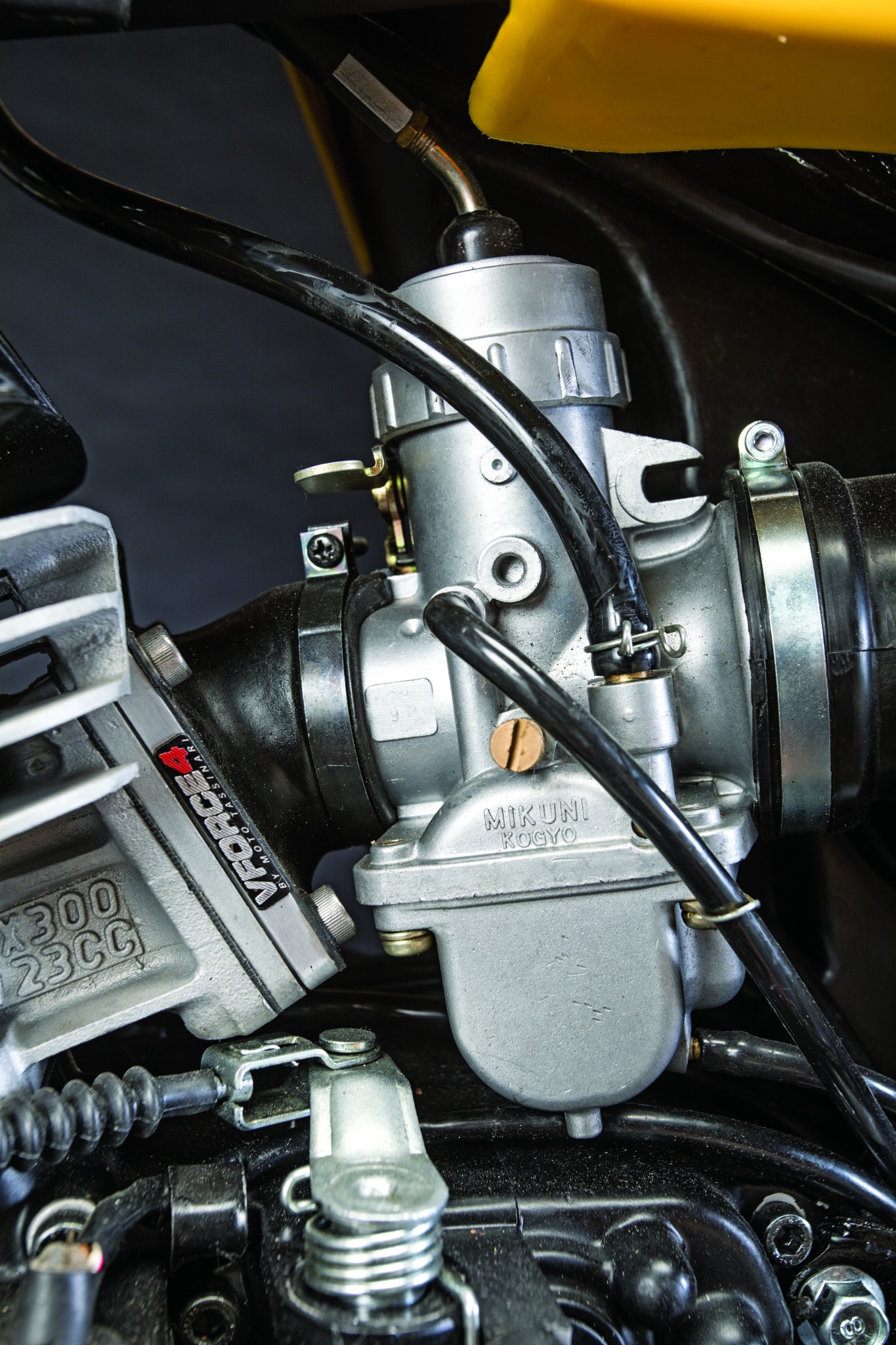 Mice had eaten the air filter and built a nest in the intake boot. The 32mm Mikuni was vapor-blasted and given new internals.
Mice had eaten the air filter and built a nest in the intake boot. The 32mm Mikuni was vapor-blasted and given new internals.
“How was it?” I asked Josh as he changed gear again to move over to work with the WP guys on the suspension settings on his KTM 300SX.
“I thought it was going to be slow, but it was pretty fast,” said Josh. “It didn’t have any bottom, but when it hit, I really took off. It hit hard in the middle. I was afraid of the leading-link forks, and even though Jody assured me that they would absorb anything, I didn’t believe him until I came up a short on one of the small doubles and braced for impact. I didn’t feel anything.”
 The rear of the YZ125 is held up by a rare Fox Mono Airshock. Its biggest flaw was air-pressure build-up late in the motos.
The rear of the YZ125 is held up by a rare Fox Mono Airshock. Its biggest flaw was air-pressure build-up late in the motos.
Now, it was my turn. In order to get up to speed quicker, I went straight to the doubles that Josh Mosiman was jumping 20 minutes earlier. I figured if a 42-year-old bike could do the StadiumCross double, it could handle Glen Helen’s outdoor tracks. I easily cleared the first double, but over-jumped a little and got into the face of the next jump too hot. Just as Mosiman said, the Thorks soaked it up. With my bravery bolstered, I headed to the REM track to start spinning laps. I thought the YZ125 would be slow, and it was, but with a very short wheelbase, amazingly low seat height and a very solid blast in the midrange, it gave the impression of doing 70 mph when it was going 20 mph. I got faster the more I rode it. I realized that my lack of confidence in a bike that I had built from the ground up wasn’t a good look for the other MXA test riders. If I expected the next test rider to go out and ride it fast, I’d better make it look good. And making it look good wasn’t that hard, because the Fox Airshox was amazingly supple. I just set the air pressure to where the owner’s manual recommended for my weight and it absorbed everything.
“I THOUGHT IT WOULD BE SLOW, AND IT WAS, BUT WITH A VERY SHORT WHEELBASE, AMAZINGLY LOW SEAT HEIGHT AND A VERY SOLID BLAST IN THE MIDRANGE, IT GAVE THE IMPRESSION OF DOING 70 MPH WHEN IT WAS GOING 20 MPH.”
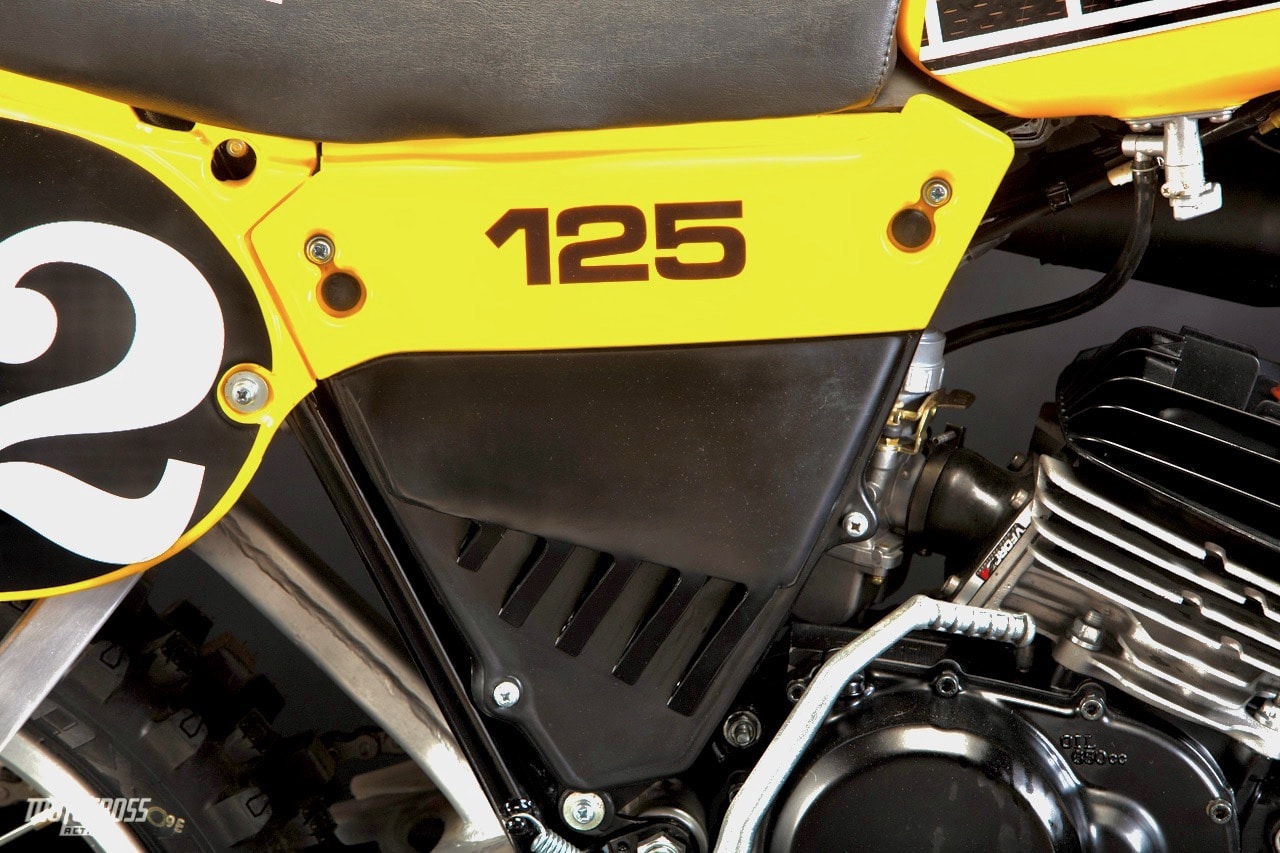
Guess what? Every MXA test rider who threw a leg over the 1979 YZ125 (not hard to do with such a low seat height) came back with a smile on his face. Equally surprising was that every test rider went straight to the StadiumCross track to jump the doubles before coming back to the outdoor track. It didn’t take long for them to jump everything on the outdoor tracks, pass a few guys and be enthusiastic about my project.
Yes, there were a few things to fix, as I found out when Jody was the last guy to ride it. He said he liked it, but thought we should move the stator plate to change the ignition timing (to clean up the boggy bottom end), put in a bigger main jet, put washers under the rear of the front fender mount to stop the fender from slapping on the front tire, order a longer clutch cable, because the one I had put on was too short, and change the spring preload on the S&W shocks on the Thorks.
I didn’t know you could change preload until he pointed at the stepped preload ring that had five notches in it to make the spring softer or harder with a twist. I paid attention to what Jody said, because he was the only MXA test rider who had ever raced a 1979 Yamaha YZ125; in fact, he had raced this exact bike at Saddleback, Indian Dunes and Carlsbad.
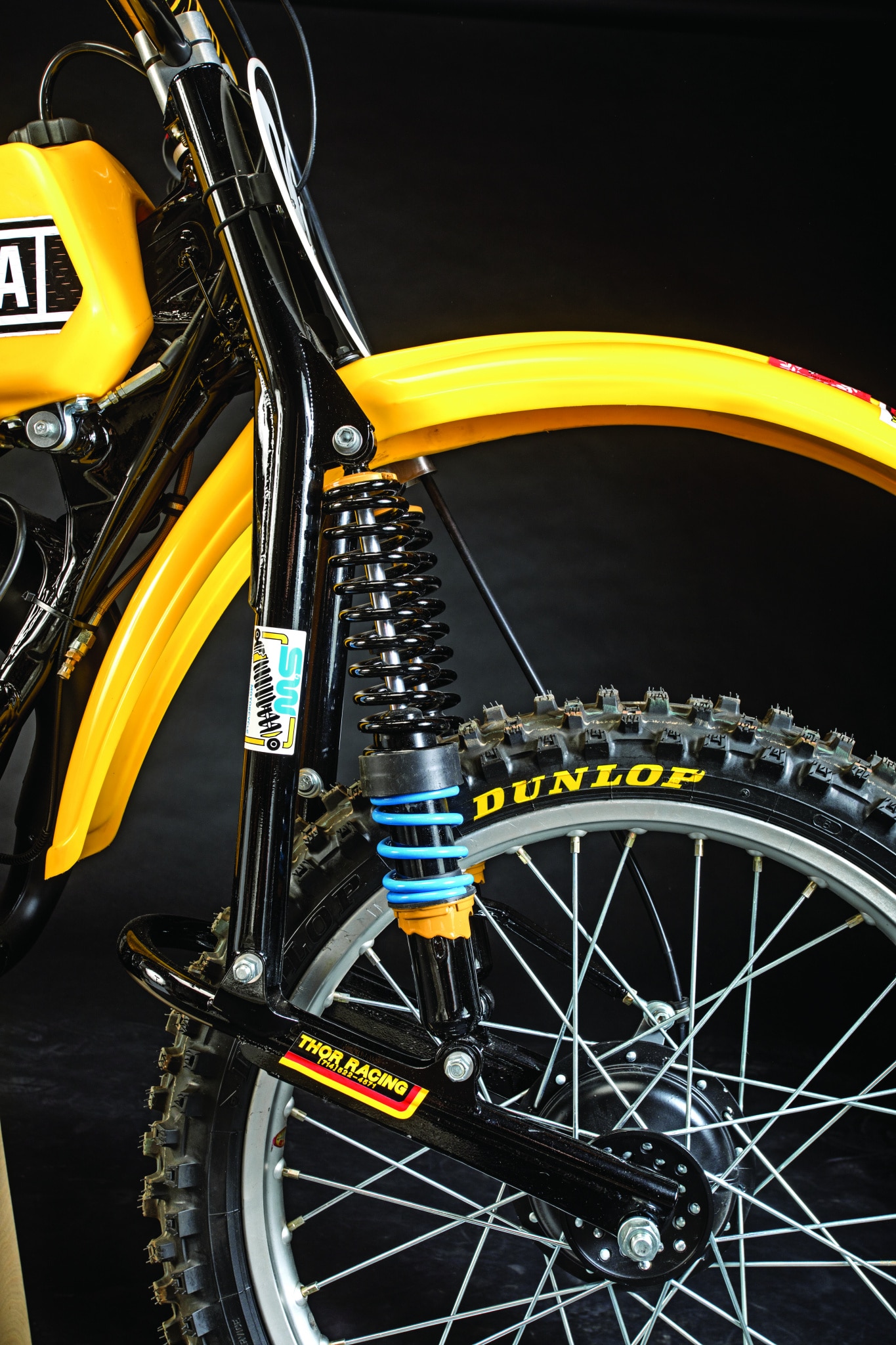 Both the Thorks and the Fox Mono Airshock are lighter than the stock Kayaba components, even if they don’t look like it.
Both the Thorks and the Fox Mono Airshock are lighter than the stock Kayaba components, even if they don’t look like it.
It took eight weeks of part-time work on the bike to finish it. I’m satisfied with how it turned out. Would I do it again? Heck yeah! My experience with the YZ125F emboldened me to acquire the dream bike I never got as a 16-year-old kid. My dream bike is a 1979 fire-engine-red Honda CR125 — you know, the one with the funky 23-inch front wheel. I’m excited to start restoring it. Oh, don’t worry, I’m still a carpenter by trade, as you can tell by the laser-engraved, custom bike stand I made from birch plywood for the YZ125F to sit on.
 The January 1979 issue of MXA had the YZ125F on the cover. The photo was shot at Indian Dunes.
The January 1979 issue of MXA had the YZ125F on the cover. The photo was shot at Indian Dunes.
1979 YAMAHA YZ125F SUPPLIERS
Cometic: www.cometic.com (gaskets)
Dunlop: www.dunlopmotorcycletires.com (tires)
RC Classic: www.rcclassics.com (guidance)
Vintage Roost: www.vintageroost.com (seat cover)
Vintage Works MX: (949) 230-1467 (Fox Airshox rebuild)
Vintco: www.vintco.com (engine parts)







Comments are closed.